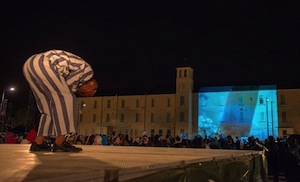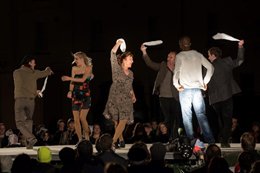The Conquest of Happiness is an ambitious piece of theatre both in the scale of its collaboration and in the scope of its source material. Based upon the philosophical writings of Bertrand Russell, the work takes as its central argument Russell’s “three passions... the longing for love, the search for knowledge, and unbearable pity for the suffering of mankind.” These three passions are then reflected in the thematic content of the performed scenes.
 The choice of performance space potentially contributed to the meanings in operation in the work. Ebrington Barracks is a ten-acre site on the river Foyle directly opposite the Guildhall Square, to which it is now connected by the pedestrian ‘Peace Bridge’. It was a military base from the 1840s, though the same site was used by Jacobite forces during the Siege of 1689; and it was a significant military base during World War II. In 2004, following the withdrawal of the British Army from Northern Ireland, the base was closed by the Ministry of Defence and is being redeveloped as a cultural quarter. The performance took place primarily in the former parade ground, an area slightly larger than Trafalgar Square, which overlooks the river and the historic city on the far side.
The choice of performance space potentially contributed to the meanings in operation in the work. Ebrington Barracks is a ten-acre site on the river Foyle directly opposite the Guildhall Square, to which it is now connected by the pedestrian ‘Peace Bridge’. It was a military base from the 1840s, though the same site was used by Jacobite forces during the Siege of 1689; and it was a significant military base during World War II. In 2004, following the withdrawal of the British Army from Northern Ireland, the base was closed by the Ministry of Defence and is being redeveloped as a cultural quarter. The performance took place primarily in the former parade ground, an area slightly larger than Trafalgar Square, which overlooks the river and the historic city on the far side.
The performance uses music, song, dance, dramatic scenes, and projected footage to create a collage of the horrors of the past century: the concentration camps and Hiroshima; My Lai and the Vietnam War; the killing fields of Cambodia; Pinochet’s Chile; the War in the Balkans; Bloody Sunday; Rwanda; September 11th, the killing of Osama Bin Laden, and Guantanamo. Cornelius Macarthy delivers sections of Russell’s text as monologues that attempt to structure the work and draw out its philosophical underpinning. And alongside the catalogue of violence and disaster are smaller vignettes of human love, compassion and friendship in the midst of carnage.
 The work began with a football match in an area of rough ground arranged to resemble a streetscape. A group of men played football while two women (one veiled, the other unveiled) organised and decorated an open shelter, hung a picture, and practiced dance exercises. The location was suggested by the veiled woman, the men’s keffiyehs, and the sense of makeshift buildings. This scene played as the crowd gathered and was accompanied by live music, until it was abruptly interrupted by the arrival of a bulldozer. One of the men began to dance with the machine, swinging from its blade, climbing over the cabin, clearly enacting a protest. A choir and community cast took up position at one end of the playing space. Finally, the machine drove into the shack the women had built, smashing it to the ground. The bulldozer then drove away, with a man in a yarmulke hanging from the cabin and cheering the driver on. The community cast and the performers then led the audience away from this section of the barracks and into the parade ground. Walking, I realised that we were gathered beneath the black banners of the Northern Ireland Civil Rights Association. The first scene in the parade ground was the scene from Bloody Sunday.
The work began with a football match in an area of rough ground arranged to resemble a streetscape. A group of men played football while two women (one veiled, the other unveiled) organised and decorated an open shelter, hung a picture, and practiced dance exercises. The location was suggested by the veiled woman, the men’s keffiyehs, and the sense of makeshift buildings. This scene played as the crowd gathered and was accompanied by live music, until it was abruptly interrupted by the arrival of a bulldozer. One of the men began to dance with the machine, swinging from its blade, climbing over the cabin, clearly enacting a protest. A choir and community cast took up position at one end of the playing space. Finally, the machine drove into the shack the women had built, smashing it to the ground. The bulldozer then drove away, with a man in a yarmulke hanging from the cabin and cheering the driver on. The community cast and the performers then led the audience away from this section of the barracks and into the parade ground. Walking, I realised that we were gathered beneath the black banners of the Northern Ireland Civil Rights Association. The first scene in the parade ground was the scene from Bloody Sunday.
Despite the setting and the potential for the material the work is ultimately unsuccessful. The individual performances are passionate and an experienced and talented cast has been assembled, and it would be fair to acknowledge the beauty and skill with which certain acts and events are represented. But overall, the representation of the individual conflicts is clichéd, often biased, and the structure of the work is weak and underdeveloped. From the first scene bulldozing a Palestinian settlement, where the only representative of Israel was celebrating destruction and was identified as a Jew by his costume, complex historical and political conflicts were reduced to easy judgments of good and evil. Although the Holocaust was the subject of a scene much later in the play, the connections between the Holocaust, Zionism, Israeli aggression and the role of the West in perpetuating the conflict were never explored. Similarly with the war in the Balkans, where Milosevič’s important assertion of the significance of Kosovo and of Serbia in European .jpg.aspx%3Fwidth=230&height=224) history was dismissed with a comment about him being a ‘troublemaker’ and quickly forgotten in representations of rape and massacre. While aesthetically these were engaging and powerful, the political complexities and the international dimensions of the conflict were not explored. This was repeatedly the case: the contextual material was under-researched and little attention had been paid to the framing of the material or to the potential for dialogue within performance.
history was dismissed with a comment about him being a ‘troublemaker’ and quickly forgotten in representations of rape and massacre. While aesthetically these were engaging and powerful, the political complexities and the international dimensions of the conflict were not explored. This was repeatedly the case: the contextual material was under-researched and little attention had been paid to the framing of the material or to the potential for dialogue within performance.
In terms of its representation of brutality, terror and violence, the piece seems content to lecture its audience on statistics, even though – as one character says – it is impossible to imagine death on a large scale. Rather than focusing on creating moments of affective connection for the audience, moments of fright or hope or pleasure, the work often tries a realistic staging which is at odds with the space and with the scale of the work. Herding the audience together in a militarised space in a city with a history like Derry’s, should have offered an opportunity to connect to memory and to evoke powerful moments of feeling and recognition. At the conclusion of the piece the audience was encouraged to move towards the wall of the barracks and to look out over the river, the Peace Bridge and the city beyond, and there was an opportunity to point to concrete evidence for hopeful outcomes from seemingly intractable conflict; evidence for happiness. Instead, the cast lined up on a platform and sang 'Five Little Ducks', encouraging the audience to join in with the words and gestures. This conclusion may be aiming at the Absurd, but it was instead banal.
This was a very well-funded, flagship project of the City of Culture with an artistic team who have the talent and skills to deliver something of beauty; but the work is diffuse, confused, and lacks a clear directorial vision. It will be interesting to see how it plays on tour in the Balkan states, and how much editorial work is done before it returns to Northern Ireland for the Belfast Festival in October.
Lisa Fitzpatrick lectures in drama at University of Ulster.